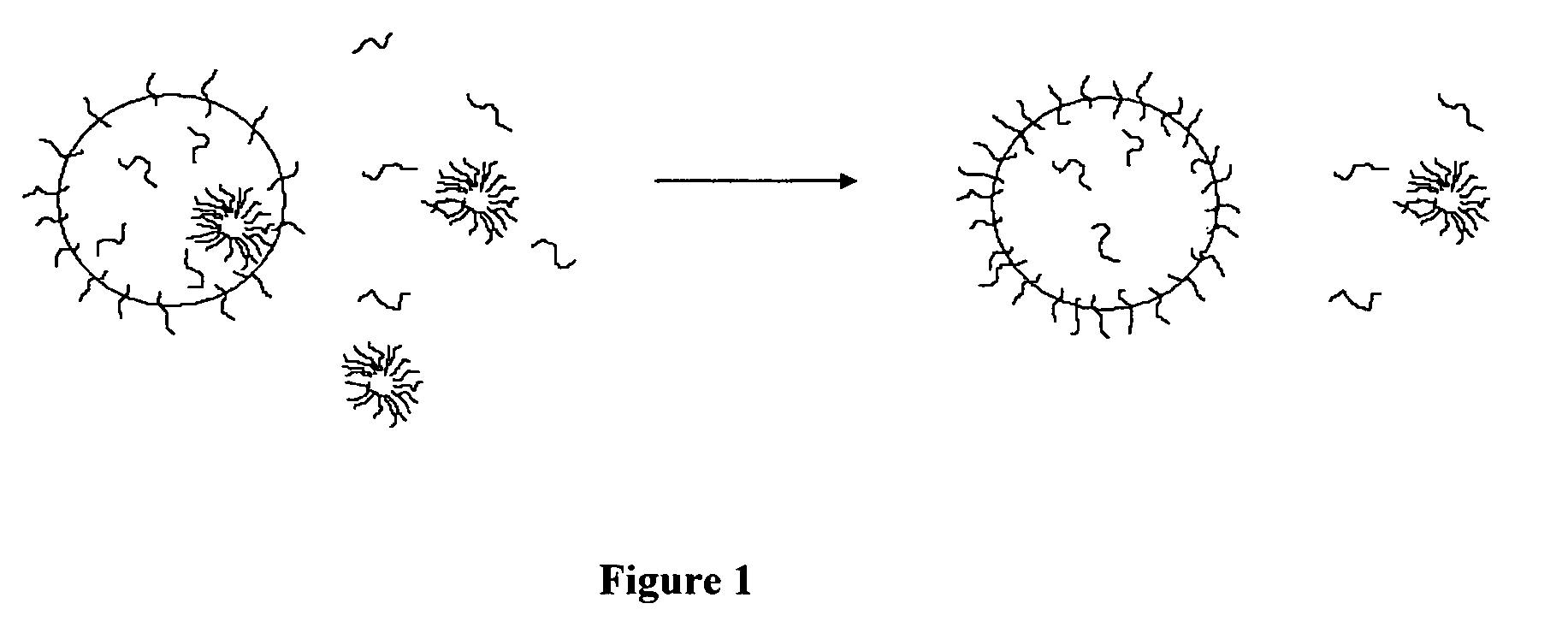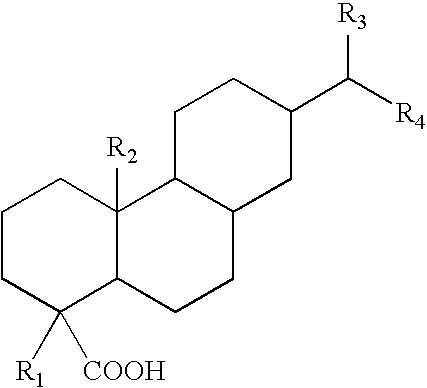Emulsifiers for use in water-based tackifier dispersions
a technology of tackifier and emulsifier, which is applied in the direction of mixing, transportation and packaging, inks, etc., can solve the problems of filter blockage, coarse particle formation in the dispersion, and holes in the final coating on the substra
- Summary
- Abstract
- Description
- Claims
- Application Information
AI Technical Summary
Benefits of technology
Problems solved by technology
Method used
Image
Examples
example 1
Preparation of Intermediate Product A (Esterification)
[0104] An electrically heated 2 liter glass reactor, equipped with agitator, thermocouple, nitrogen inlet and Dean-Stark trap with cooler, was charged with Gum Rosin (Eastman Chemical Company, Middelburg, NL) and polyethylene glycol (PEG300; Aldrich Chemical Company Milwaukee, Wis.) with a number average molecular weight of 300 in a molar equivalent ratio of COOH:OH =1:10. The mixture was heated under inert nitrogen conditions to 180° C. and 0.01% ZnO (based on the weight of Gum Rosin) was added as esterification catalyst. The mixture was further heated to 290° C. and water was continuously distilled off.
[0105] The reaction mixture was allowed to react until a conversion of at least 90% was reached. Typical reaction times were between 25 and 30 hours. The raw intermediate was cooled to ambient and dissolved in diethyl ether. 100 parts raw product was dissolved in 80 parts diethyl ether. 67 parts of an aqueous NaCl-solution (2% ...
example 2
Preparation of Intermediate Product B (Esterification)
[0106] The procedure of Example 1 was repeated by replacing PEG 300 by polyethylene glycol (PEG200; Aldrich Chemical Company Milwaukee, Wis.) with a number average molecular weight of 200.
example 3
Preparation of Intermediate Product C (Ethoxylation)
[0107] A 1 liter autoclave, equipped with agitator, thermocouple, nitrogen inlet and pressure gauge was heated to approximately 85° C. and charged with 300 g Abitol E (Eastman Chemical Company, Middelburg, NL) and 0.3 g KOH-powder. Agitation was started at 500 rpm. The reactor was inerted three times with nitrogen. The mixture was heated to 180° C. Ethylene oxide (generally 5, 7, 9 or 11 moles) was continuously added to the reactor in about 16 hours, using a dosing vessel pressurized to 5 bars. The pressure in the reactor was 4.7 bars. The mixture was allowed to react overnight. The reactor was inerted three times with nitrogen and cooled to ambient temperature and discharged. The preferred molar ratio Abitol E:EO is 1:7.
PUM
| Property | Measurement | Unit |
|---|---|---|
| particle size | aaaaa | aaaaa |
| particle size | aaaaa | aaaaa |
| particle size | aaaaa | aaaaa |
Abstract
Description
Claims
Application Information
 Login to View More
Login to View More - R&D
- Intellectual Property
- Life Sciences
- Materials
- Tech Scout
- Unparalleled Data Quality
- Higher Quality Content
- 60% Fewer Hallucinations
Browse by: Latest US Patents, China's latest patents, Technical Efficacy Thesaurus, Application Domain, Technology Topic, Popular Technical Reports.
© 2025 PatSnap. All rights reserved.Legal|Privacy policy|Modern Slavery Act Transparency Statement|Sitemap|About US| Contact US: help@patsnap.com



